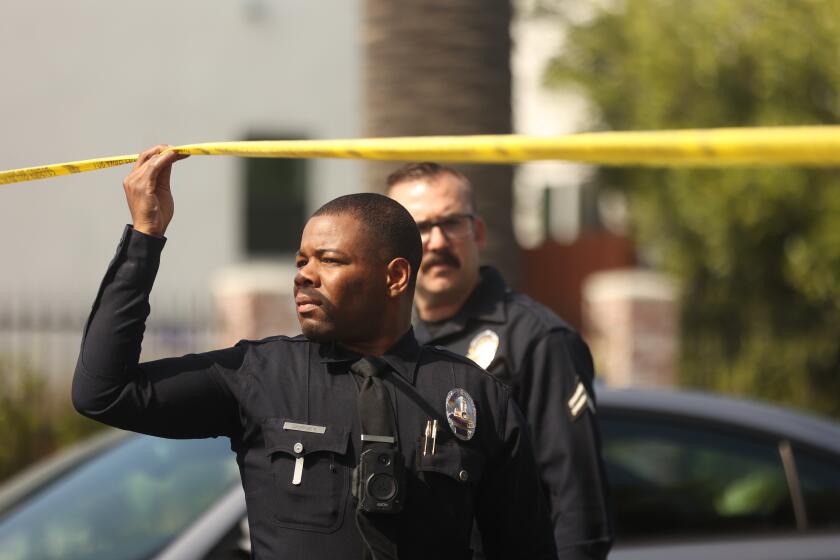Proposed apartments along Expo Line in South L.A. draw comment from backers, foes
- Share via
Hundreds of people converged Thursday on City Hall as the Los Angeles Planning Commission considered one of South L.A.’s largest and most controversial building proposals: the $250-million Lorenzo development of Geoffrey H. Palmer, whose Italian-themed downtown apartment complexes have drawn both praise and condemnation.
Supporters and opponents voiced their opinions about the proposal from Palmer, whose other downtown projects include the Medici, Visconti, Orsini and Piero. This one would be along the new light-rail Exposition Line.
After hours of debate and questions, the commission put off a vote until Feb. 10. The developer was asked to consider some revisions in design, pedestrian access, bicycle access and landscaping.
The commission must vote on whether to allow the project on a site zoned for medical or educational services. The lot slated for development now contains a pair of parking lots.
Backers called the 900-plus unit project near USC an employment-generating addition to a district lacking high-quality rental and retail choices. Opponents labeled the development a case of putting luxury apartments above the housing and health needs of a struggling, mostly working-class community.
Opponents are contemplating a civil rights action against the city if the project advances, said Serena Lin, an attorney with Public Counsel, a legal aid group. The developer depicted the project as a major improvement for the community, providing jobs, housing and a pedestrian-oriented atmosphere.
Apart from its size and the controversy it has generated, the project is closely watched because of its link to mass transit. The complex would be next to a planned Expo Line station, just a stop away from both USC and the Los Angeles Convention Center. As city leaders embrace public transportation as an alternative to gridlocked freeways, planners are focusing on the nexus between mass transit and urban development.
“It’s the first transit-oriented project in South Los Angeles, and it will probably have a weight as to how we design future projects,” said Faisal A. Roble, a senior city planner, who called the development one of the community’s largest in decades.
The Lorenzo, on property previously held by Los Angeles Orthopaedic Hospital at 23rd and Flower streets, would include 919 apartments and 34,000 square feet of retail space. The developer says it would create more than 1,800 construction jobs, generate more than $100 million in labor income and provide a permanent boost to property tax revenues and area spending — alluring attributes in an era of sweeping fiscal retrenchment.
An original proposal was even larger, encompassing 1,400 units and a 44-story tower. But Palmer, who purchased the nine-acre site from Orthopaedic Hospital for $70 million, scaled down the Lorenzo amid community concerns about its size.
Palmer, who has gone to court to battle affordable-housing mandates, has pledged to set aside 5% of the units for “very low-income” tenants.
But the gesture hasn’t mollified critics who say the neighborhood needs more clinics, not high-end rentals.
“South Los Angeles is a medically underserved community in desperate need of healthcare resources,” said Paulina Gonzalez, executive director of Strategic Actions for a Just Economy, a nonprofit advocacy group opposed to Palmer’s plan.
Opponents are asking city planners to put off a decision until they have time to craft an alternative that would bring healthcare services to the site.
Palmer and backers of the project say it would enhance the community and argue that it is unlikely another hospital would choose to relocate to the site. Orthopaedic Hospital still runs an outpatient clinic on an adjacent parcel, supporters note, and California Hospital Medical Center is less than a mile away.
Nonetheless, the developer says he is sensitive to neighborhood concerns. “We want to work to identify programs that we can support which will provide for improved healthcare opportunities for the community,” said Greg Smith, vice president of GH Palmer Associates.
City Councilwoman Jan Perry, whose district includes the site, says she has not taken a position but is hopeful a compromise can be worked out before the proposal comes before the council.
“I want to allow the developer and community groups time to see if there’s a consensus to be reached,” Perry said.
More to Read
Sign up for Essential California
The most important California stories and recommendations in your inbox every morning.
You may occasionally receive promotional content from the Los Angeles Times.













